-
Paper Information
- Paper Submission
-
Journal Information
- About This Journal
- Editorial Board
- Current Issue
- Archive
- Author Guidelines
- Contact Us
International Journal of Psychology and Behavioral Sciences
p-ISSN: 2163-1948 e-ISSN: 2163-1956
2025; 15(1): 16-25
doi:10.5923/j.ijpbs.20251501.03
Received: Feb. 16, 2025; Accepted: Mar. 9, 2025; Published: Mar. 11, 2025

Building Anti-Fragility – Cases on Poverty Elimination from Mauritania
1Founder, International Institute of Inspiration Economy, Bahrain
2Socioeconomic Institute for Advanced Studies (SIAS), Rwanda
Correspondence to: Mohamed Buheji, Founder, International Institute of Inspiration Economy, Bahrain.
| Email: |  |
Copyright © 2025 The Author(s). Published by Scientific & Academic Publishing.
This work is licensed under the Creative Commons Attribution International License (CC BY).
http://creativecommons.org/licenses/by/4.0/

This paper presents a comprehensive overview of the Inspiration Cooperatives initiative in the Lemghity neighbourhood of Nouakchott, in Mauritania, aimed at poverty alleviation and community development through cooperative projects. The initiative, led by Al-Irada Association in partnership with the International Inspiration Economy Project, focuses on empowering women and youth by establishing cooperatives in various fields such as sewing, dyeing, poultry farming, and event management with guided anti-fragility enablers. The paper outlines the cooperatives' initial vision, practical implementation, and monitoring mechanisms, highlighting their growth, challenges, and social impacts within the neighbourhood. Key findings include significant improvements in income generation, increased community engagement, and the introduction of innovative solutions that comes from within the neighborhood to address challenges such as weak marketing and low educational levels. The paper emphasizes the importance of continuous guidance, training, social support, and educational programs to ensure the anti-fragility sustainability and scalability of the targeted families in specific poor neighbourhoods. By documenting the progress and lessons learned, this study contributes to the broader discourse on cooperative-based poverty alleviation and community development in underserved regions with a focus on anti-fragility.
Keywords: Anti-fragility, Poverty Vulnerable Community, Mauritania, Poverty Elimination, Inspiration Economy, Cooperatives in Neighbourhoods
Cite this paper: Mohamed Buheji, Building Anti-Fragility – Cases on Poverty Elimination from Mauritania, International Journal of Psychology and Behavioral Sciences, Vol. 15 No. 1, 2025, pp. 16-25. doi: 10.5923/j.ijpbs.20251501.03.
Article Outline
1. Introduction
- The Lemghity neighbourhood in Nouakchott, Mauritania, is a densely populated area characterized by high levels of poverty, vulnerability, and illiteracy. Historically part of informal settlements, the neighbourhood has recently been integrated into the urban planning scheme, with most families now owning registered plots of land. However, access to basic services remains limited, and the community continues to face significant socio-economic challenges. The average family size is six members, with low educational attainment among adults and high rates of school dropout among children. These conditions have perpetuated cycles of poverty and limited opportunities for economic and social advancement. In response to these challenges, Al-Irada Association, in collaboration with the International Project for the Economy of Inspiration, launched the Inspiration Cooperatives initiative. This initiative aims to empower women and youth by establishing cooperatives in various income-generating activities, such as sewing, dyeing, poultry farming, and event management. The project seeks to foster a spirit of cooperation, improve living standards, and create sustainable economic opportunities for community members. By focusing on education, skill development, and social support, the initiative aims to address the root causes of poverty and promote long-term community development.
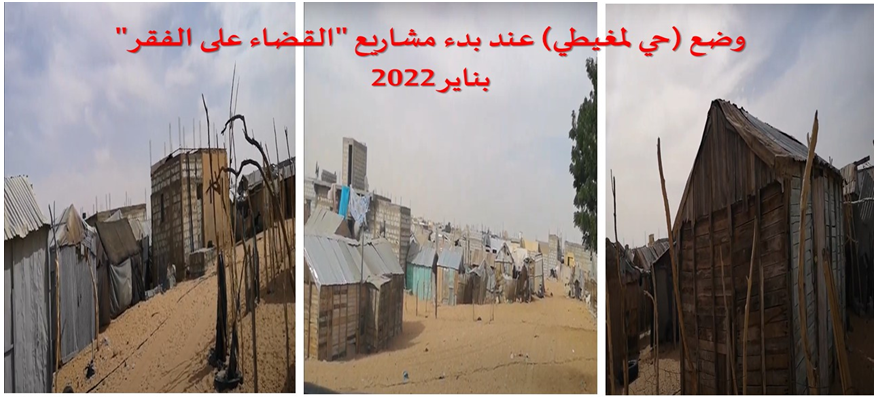 | Figure (1). Shows a Photo of the Lemghity neighbourhood in Nouakchott, Mauritania, at the time of the initiation of the Poverty Elimination Project through Anti-Fragility Approaches in January 2022 |
2. Literature Review
- The concept of cooperatives as a tool for poverty alleviation and community development has been widely studied and implemented across various regions, particularly in underserved and marginalized communities. Cooperatives are member-owned organizations that operate on principles of mutual aid, democratic decision-making, and shared benefits. They have been recognized as effective mechanisms for empowering individuals, and enhancing their anti-fragility, particularly women and youth, by providing minimum access to resources, training, and markets (Birchall & Simmons, 2004). In the context of Sub-Saharan Africa, cooperatives have played a significant role in addressing socio-economic challenges such as poverty, unemployment, and gender inequality, Ajaj et al. (2024). Studies have shown that cooperatives can enhance income generation, improve access to education and healthcare, and foster social cohesion (Develtere et al., 2008). For example, women's cooperatives in rural Kenya have been successful in improving household incomes and promoting gender equality through collective economic activities (Ochieng et al., 2017). Similarly, youth cooperatives in South Africa have provided opportunities for skill development and entrepreneurship, contributing to reduced unemployment and increased social inclusion (Philip, 2010). However, cooperatives' success is often contingent on several factors, including effective leadership, access to financial resources, and supportive policy frameworks. Challenges such as weak marketing, lack of training, and limited access to markets can hinder their growth and sustainability (Wanyama et al., 2009). To address these challenges, interventions such as capacity-building programs, market linkages, and partnerships with external organizations have been recommended (Mazzarol et al., 2014). The socio-economic context of Mauritania presents unique challenges and opportunities for cooperative development. The country has a high poverty rate, with significant disparities in access to education and economic opportunities, particularly for women and youth (World Bank, 2020a). The Inspiration Cooperatives initiative builds on the global evidence of cooperative success while adapting to the local context. By focusing on education, skill development, and social support, the initiative aims to address the root causes of poverty and promote sustainable community development. This paper contributes to the existing literature by providing a case study of the Inspiration Cooperatives initiative in the Lemghity neighbourhood. It highlights the strategies, outcomes, and challenges of the initiative, offering valuable insights for policymakers, practitioners, and researchers interested in cooperative-based models for poverty alleviation and community development.
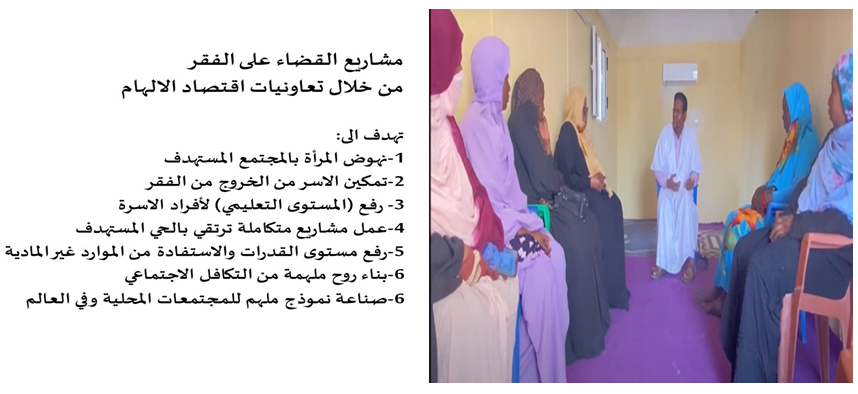 | Figure (2). Photo of the initial meetings and List of Requirements Presented by Al-Irada Association Leader Dr Elhadi Elmoneer the partner with the Inspiration Economy Projects in Mauritania |
2.1. Building Anti-Fragility in a Community
- The concept of anti-fragility, introduced by Nassim Nicholas Taleb (2012), refers to systems or entities that not only withstand shocks and stressors but also thrive and improve as a result of them. In the context of poverty elimination, building anti-fragility involves creating systems, communities, and individuals that are resilient to economic, social, and environmental challenges while leveraging these challenges as opportunities for growth and transformation. This literature review explores the theoretical foundations of anti-fragility and its application in poverty alleviation, with a focus on case studies from Mauritania.
2.2. Theoretical Foundations of Anti-Fragility
- Anti-fragility extends beyond resilience, which focuses on the ability to recover from adversity. Instead, anti-fragile systems, and that’s include communities are designed to benefit from volatility, uncertainty, and disorder. Taleb (2012) argues that anti-fragility is essential for survival and growth in complex and unpredictable environments. In the context of poverty, anti-fragility can be achieved through diversification of income sources, decentralized decision-making, and the cultivation of adaptive capacities (Taleb, 2012). The application of anti-fragility in development programs emphasizes the importance of local ownership, participatory approaches, and flexible interventions that can adapt to changing circumstances (Chambers, 1997). For example, community-based cooperatives and self-help groups have been shown to enhance anti-fragility by empowering individuals to take collective action, share risks, and innovate in response to challenges (Birchall & Simmons, 2004).The Anti-fragility formula mainly consists of exposure to volatility (stressors). The theory emphasizes that to build an anti-fragile system or community, people need to be exposed to manageable levels of volatility, randomness, and stress. This exposure allows them to adapt, learn, and grow stronger over time.Antifragility theory also requires the provision of optionality, i.e., building within the designed setup the ability to choose. Antifragile systems or communities can develop best when having options that help to build the ability to pivot, experiment, and take advantage of opportunities that arise from uncertainty. This reduces the community's vulnerability by ensuring they are not locked into a single, rigid path to come out of poverty.To sustain robust, anti-fragile systems or communities, redundancy needs to be built within the system. This redundancy would help to work as a buffer against shocks, reducing vulnerability by ensuring that failures in one area do not lead to catastrophic collapse.Part of the design also for the anti-fragile systems or communities is decentralisation. This means the community would not rely on a single point of resource or whatever would increase its failure to come out of poverty. This reduces vulnerability by spreading risk across multiple components.The other important thing in the design of an Anti-fragile system or community is to have skin in the Game, which means having accountability. This requires that we align vulnerability by aligning incentives and discouraging reckless behaviours. This is important so that the community embraces experiential learning through applying trial and Error or learning by failure to create a culture of continuous improvement. This participates in building anti-fragility, which reduces vulnerability by preventing the accumulation of hidden risks that could lead to catastrophic failure.Mathematical Representation:While Nasim Taleb (2012) did not provide a strict mathematical formula, the collection of his theory emphasises that anti-fragility participation in vulnerability reduction can be conceptualized as follows:Vulnerability Reduction =
 Having. Anti-Fragility = Exposure to Volatility + Optionality + Redundancy + Decentralization + Skin in the Game + Small Failures.In other words, as anti-fragility increases, vulnerability decreases. i.e. The more a system can benefit from disorder and stress, the less vulnerable it becomes to future shocks.
Having. Anti-Fragility = Exposure to Volatility + Optionality + Redundancy + Decentralization + Skin in the Game + Small Failures.In other words, as anti-fragility increases, vulnerability decreases. i.e. The more a system can benefit from disorder and stress, the less vulnerable it becomes to future shocks.2.3. Anti-Fragility in Poverty Alleviation
- Poverty is often characterized by vulnerability to external shocks, such as economic downturns, climate change, and health crises. Addressing these vulnerabilities while fostering opportunities for growth and self-reliance is essential to building anti-fragility in poverty-stricken communities. There are key proven strategies for eliminating vulnerability and enhancing the anti-fragility of any community, but more specifically, poor communities. One of them is economic diversification. This reduces dependence on a single income source by promoting multiple livelihood options, such as agriculture, small-scale enterprises, and customised vocational training (Ellis, 2000). Other strategies to enhance the antifragility of a poor community include investing in social capital and strengthening community networks and trust to facilitate collective action, resource sharing, and mutual support (Woolcock & Narayan, 2000). Then, education and skills development come through equipping individuals with the knowledge and skills needed to adapt to changing circumstances and seize new opportunities (Sen, 1999). Case studies from Sub-Saharan Africa highlight the potential of anti-fragile approaches to poverty alleviation. For example, microfinance initiatives in Kenya have enabled women to diversify their income sources and build resilience to economic shocks (Ochieng et al., 2017). Similarly, community-based adaptation programs in Ethiopia have empowered farmers to cope with climate variability through innovative agricultural practices (Dercon et al., 2005). Nassim Taleb's concept of anti-fragility is central to his philosophy of how systems, individuals, and organizations can thrive in the face of uncertainty, volatility, and stress. Anti-fragility goes beyond resilience (the ability to withstand shocks) or robustness (the ability to remain unchanged). Instead, anti-fragile systems actually benefit from disorder, randomness, and stressors, becoming stronger and more capable as a result.The link between anti-fragility and the reduction of vulnerability is a key theme in Taleb's work, particularly in his book Antifragile: Things That Gain from Disorder. The formula or framework that connects these two concepts can be summarized as follows:
2.4. Role of Anti-fragility Design in Reducing Community Vulnerability
- The anti-fragility framework reduces vulnerability by ensuring that the targeted community cannot only withstand shocks but also learn and adapt from them. Hence, by exposing the community to manageable levels of stress, they become less fragile and more capable of handling larger shocks in the future, reducing their vulnerability to unexpected events.Having multiple options ensures that systems are not overly dependent on a single strategy or outcome. This reduces vulnerability by providing flexibility and adaptability.Redundancy acts as a safety net, ensuring that failures in one area do not lead to system-wide collapse. This reduces vulnerability by spreading the risk. By designing a decentralized community system, the community becomes less vulnerable to single points of failure, as risks are distributed across multiple components. Also, accountability within the community would be greater, as people and families within it would have a personal stake in the anti-fragility project outcomes.The anti-fragility design encourages communities to identify and address weaknesses before they escalate into larger problems. This reduces vulnerability by promoting continuous improvement.
3. Methodology
3.1. Research Design
- This study adopts a qualitative and a quantitative research approach to provide a comprehensive understanding of the Inspiration Cooperatives initiative and its impact using the Anti-fragility theory. The research design is descriptive and exploratory, aiming to document the implementation process, assess outcomes, and identify challenges and lessons learned. The study is grounded in the principles of anti-fragility, as proposed by Nassim Nicholas Taleb (2012), and focuses on how the initiative builds resilience and reduces vulnerability in the Lemghity neighbourhood.
3.2. Baseline Establishment
- A household survey was conducted to collect demographic and socio-economic data from families in the Lemghity neighbourhood. The survey covered topics such as income levels, education, access to services, and participation in community activities. Also, focus group discussions were held with women and youth to understand their perceptions of poverty, challenges, and aspirations. These discussions helped identify potential participants for the cooperatives and informed the design of the initiative.The interviews were conducted with community leaders, representatives of Al-Irada Association, and local government officials to gather insights into the neighbourhood's historical and socio-economic context.
3.3. Implementation Monitoring
- Volunteered sociology students from the local university of Nouakchott observed the establishment and operation of the cooperatives, including attending meetings, training sessions, and production activities. Administrative records, financial reports, and meeting minutes from the cooperatives were reviewed to track progress and identify challenges. The cooperatives submitted regular reports on their activities, profits, and social impacts. These reports were analysed to monitor growth and adherence to the initiative’s guidelines.
3.4. Outcome Evaluation to Develop the Selected Cases
- A follow-up survey was conducted with cooperative members and their families to assess changes in income, living standards, and access to education. Then, in-depth case studies were developed for three cooperatives (Mat Moulana, Al-Nasr, and Al-Tasamoh) to document their journeys, challenges, and successes. Finally, feedback was collected from cooperative members, Al-Irada Association staff, and community leaders to evaluate the initiative’s effectiveness and identify areas for improvement.
3.5. Quantitative Analysis
- The survey data were analysed to calculate baseline and follow-up indicators, such as average income, literacy rates, and school enrolment. The financial data from the cooperatives were used to calculate growth rates, profit distributions, and reinvestment levels. Pre- and post-intervention data were compared to assess the initiative's impact on poverty reduction and community development.
4. Introduction to Poverty and Anti-Fragility Project in Mauritania
4.1. Introduction to Situation of the Project
- According to the International Trade Administration (2024), Mauritania struggles with persistent poverty, which affects over 50 per cent of the population and includes food and water shortages. The illiteracy rate of the population is still estimated at around 30-50 per cent. The country also faces a shortage of skilled labour. ITA (2023)Mauritania faces significant challenges in poverty alleviation, including high levels of inequality, limited access to education and healthcare, and vulnerability to climate change (World Bank, 2020a). Traditional approaches to poverty reduction have often focused on short-term relief rather than long-term empowerment, leaving communities ill-equipped to handle future shocks. Mauritania is at risk of hydrometeorological hazards and natural disasters. Climate change is expected to increase the risks and severity of natural disasters in Mauritania. The rising intense temperatures, prolonged heat waves, and heightened rainfall variability make the country more prone to droughts and floodings, which would cause human displacement and increased urbanisation. This would create more damage to any potential crops, further increasing the water stress, which is likely to result in significant economic losses and damage to agricultural lands as well as human health. Hence, this increases the vulnerability of the country communities as they continue to stay dependent on ‘climate change’ sensitive resources such as agriculture, fisheries, mining and livestock. Climate Change Knowledge Portal (2020) As per Oxfam (2024), Mauritania suffers from deterioration of the factors and conditions of production, global warming and recurrent disasters, incoherent policies, and bad governance. These factors hinder development and contribute to the weakening and impoverishment of the rural population. These factors keep more than 16.6% of the population living below the extreme poverty line.The World Bank (2020b) mentioned better consumption per family over the years in urban areas (excluding Nouakchott). Poverty reduction in rural areas was driven by higher agricultural production, more favourable prices, and the out-migration of the poor to Nouakchott. In urban areas, poverty reduction benefited from increased transport, construction, and informal retail activities. In Nouakchott, poverty increased because of an influx of poor migrants and higher prices, especially of food products, which hurt net consumers.
4.2. Brief on the ‘Lemghity Neighbourhood’ of Nouakchott Project
- In the heart of Nouakchott, Mauritania, lies the Lemghity Neighbourhood—a densely populated area that has long grappled with poverty, vulnerability, and illiteracy. Once an informal settlement, it was recently integrated into the city’s urban planning scheme. While families now own registered plots of land, access to essential services remains a distant dream. The average household comprises six members, many of whom lack formal education. The youth face many challenges: dropping out of school, idleness, and a lack of guidance. Charitable organisations have stepped in over the years, offering temporary relief, but the root causes of poverty persist. Enter Al-Irada Association, a beacon of hope, determined to bring lasting change through a groundbreaking initiative: the Lemghity Neighbourhood Cooperatives.The Inspiration Cooperatives initiative in the Lemghity neighbourhood of Nouakchott represents an innovative approach to building anti-fragility in Mauritania. The initiative has enabled women and youth to diversify their income sources and build resilience to economic shocks by establishing cooperatives in diverse fields such as sewing, dyeing, and poultry farming. The emphasis on education, skill development, and social support has further enhanced the adaptive capacities of community members, enabling them to thrive in the face of adversity. The success of the Inspiration Cooperatives initiative aligns with the principles of anti-fragility, as it leverages local resources, fosters community ownership, and adapts to changing circumstances. For example, the introduction of short-term loans from cooperative profits has provided members with a safety net during emergencies, while the focus on finding small niches suitable for the community enabled the coop members to seize them and bring new opportunities to the neighbourhood market.
4.3. A Vision Takes Shape
4.3.1. Background on the Initiative of Raising a Neighbourhood Anti-Fragility
- On January 15, 2022, the Al-Irada Association, in partnership with the International Inspiration Economy Project, initiated an initiative to transform lives in Lemghity. The clear mission was to create a network of cooperatives to empower the community, particularly women and youth, by fostering productivity, self-reliance, and a sense of purpose. The initial vision was ambitious yet practical. The initiative aimed to attract the neighbourhood’s leaders, harnessing their energy and potential through orientation sessions that help them to visualise opportunities for life improvements. The initiative started with the existing talents and the poor infrastructure but with clear key performance indicators. The initiative established and revitalised existing weak cooperatives. The plan included opening a field office in the neighbourhood, conducting surveys to assess needs, and collaborating with the local university sociology students to support the development stages. Literacy programs for mothers, incentives for academically outstanding children, and training spaces for skill development were also part of the blueprint. The association’s holistic approach addressed not just economic needs but also social and educational gaps.The target was to establish 10 different types of cooperatives in the neighbourhood, with each cooperative comprising 10 to 20 women. The decision was to start with only three cooperatives at most and monitor their work, profitability, and reports for the first 3 to 6 months before deciding whether to expand. Each cooperative should include at least 20 women.
4.3.1.1. Setup Guideline for Each Coop
- Each cooperative started with a capital of no more than $500, and the association will share in its profits. The association will immediately begin monitoring administrative reports and sending them for feedback. Cooperatives will be evaluated based on points distributed across: - Teamwork. - Quality of productivity. - Effective marketing and profitability. - Social impacts. - Knowledge sharing. - Scalability. Any cooperative that does not achieve 40% of the points in the first evaluation will receive a warning, and if it does not reach 45% in the second evaluation, it will be restructured. The following was the distribution expected from each of the coops profits: - 10% to increase capital for project development. - 10% for savings or reinvestment to open another project. - 10% for social spending on cases within the families of project members. - 70% distributed among members participating in the economic cycle. All the coops needed to overcome the cultural challenges in:- Weak marketing through finding a weekly space to market products. - Low educational levels can be achieved by launching literacy programs for members. - Family obligations and poor time management through providing continuous administrative follow-up for projects. - Lack of experience and uneven distribution of work among members through training members internally and bringing external trainers. Project Monitoring Phases: 1. The project will be monitored over several phases for two years. All project stages will be documented, and monthly, quarterly, and general financial and social reports will be prepared. 2. The first six months will be a continuous monitoring phase. 3. The second six months of the first year will show the project's financial benefits and the group's overcoming of initial difficulties. 4. The remaining period will focus on reaping the project's fruits, gaining the necessary experience for its development, and creating a well-studied plan for evaluation. Measure the Overall Project Objectives from all the Coops in the Neighbourhood: - Improve the living standards of the group's families. - Focus on teamwork and demonstrate its effectiveness. - Use returns to support the education of beneficiaries' children. - Ensure greater returns by monitoring production and marketing. - Provide a space to display products to attract more customers. - Training is essential for the group in commerce, cooperation, and self-development.
4.3.1.2. Monitoring Methods
- After the minimum appropriate funding for the cooperative and its activity and needs are determined, the initiative office will provide what is necessary to start work. The cooperative leaders will be guided on marketing methods, sales organisation, profit calculation, and financial management. The assistant sends a weekly report to monitor the project's continuity and development prospects. To facilitate monitoring, profits from each coop were calculated for each production cycle, not exceeding 45 days. The women members of the cooperatives are also invited to a monthly discussion session to identify obstacles and problems they face and find solutions.
4.3.2. Grouping the Cooperatives
- The initiative worked on creating cooperatives (coops, for short) that provide some shared services for the projects, foster a competitive spirit among them, monitor their social impacts, and attempt early intervention to address problems. In parallel, the initiative team opened a field office in the neighbourhood. The initial neighbourhood survey was conducted to assess the situation at the start of the projects. The initiative was also chosen to collaborate with sociology students from the University of Nouakchott to support the monitoring of developments, including the introductory demographic survey. The neighbourhood office opened a class to educate the mothers about the importance of the cooperative and the way it should be managed so that it participates in improving both the family and neighbourhood life. The office also created an agreement with the cooperative members to ensure their commitment. The initiative also established a mechanism to encourage academically outstanding children in the neighbourhood. The agreement was that each cooperative should start partially funding other cooperatives from the net profit once it began to have stability in production and selling.
4.3.3. Case of Mat Moulana Cooperative – ‘A Strong Start’
- On January 19, 2022, the Mat Moulana Cooperative was launched, marking the beginning of this transformative journey. Comprising 23 women, the cooperative focused on diverse activities: selling women’s necessities, wedding decorations, and traditional garments known as milhafas. The women purchased raw materials and began production with an initial capital of 9,000 Ouguiya (approximately $240). Despite challenges like weak marketing and low educational levels, the cooperative showed promise. Within the first month, it grew over 30%, a testament to the women’s determination and the association’s support.The simple cooperative’s profit distribution plan was designed to ensure sustainability and reinvestment. Ten per cent of profits would go toward increasing capital, another 10 per cent toward savings or new projects, and 10 per cent toward social spending for members’ families. The remaining 70 per cent would be distributed among the women, providing them much-needed income. The association also introduced literacy programs and administrative training to address key challenges, ensuring the cooperative’s long-term success.
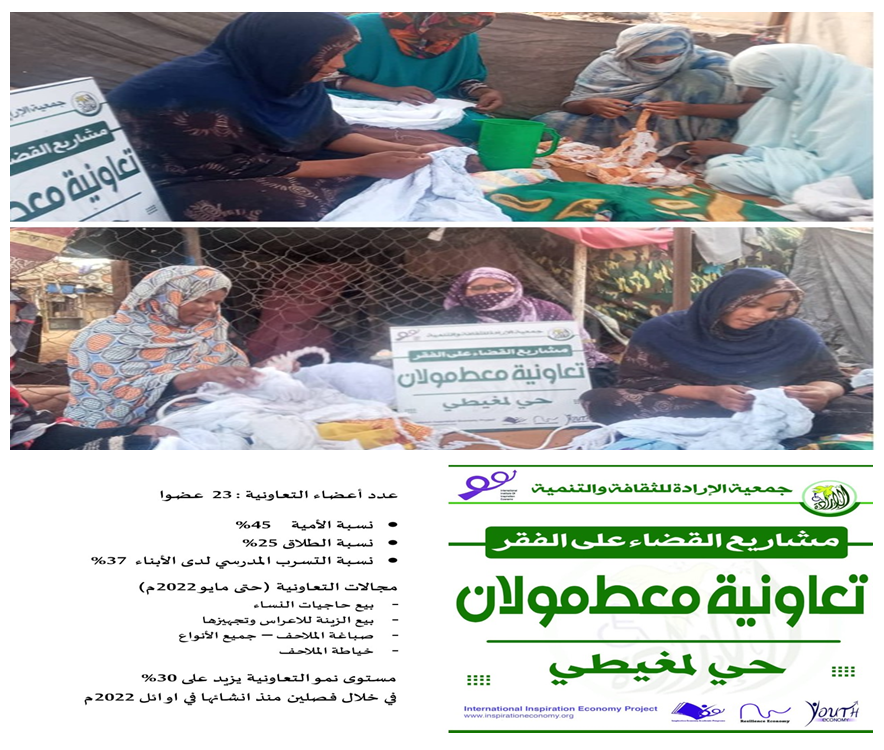 | Figure (3). Cover Reflects the ‘Mat Moulana Cooperative’ Team members |
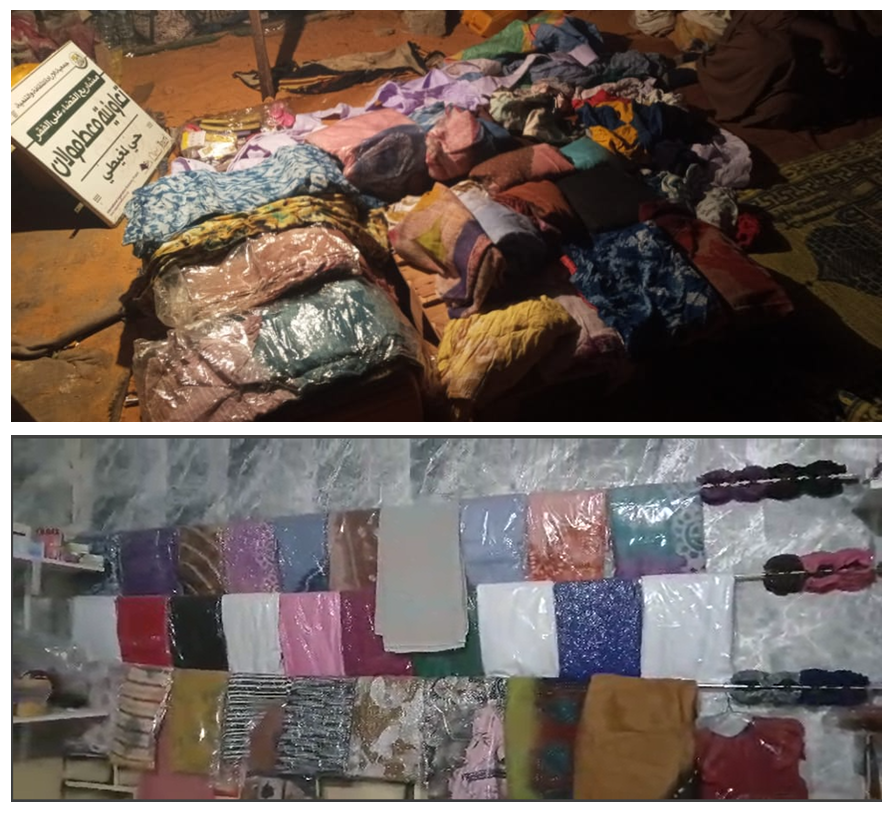 | Figure (4). Photo Illustrates the Development in the Production of ‘Mat Moulana Cooperative’ |
4.3.4. Case of Al-Nasr Cooperative – ‘A Story of Resilience’
- Just three days later, on January 22, 2022, the Al-Nasr Cooperative joined the initiative. With 29 members, this cooperative was already operational but needed support to scale its activities. From running a grocery store to sewing milhafas, organizing events, and even poultry farming, the cooperative’s diverse ventures showcased the women’s entrepreneurial spirit. With a $380 injection of capital, the cooperative expanded its operations, focusing on both product sales and rental services within the neighbourhood.
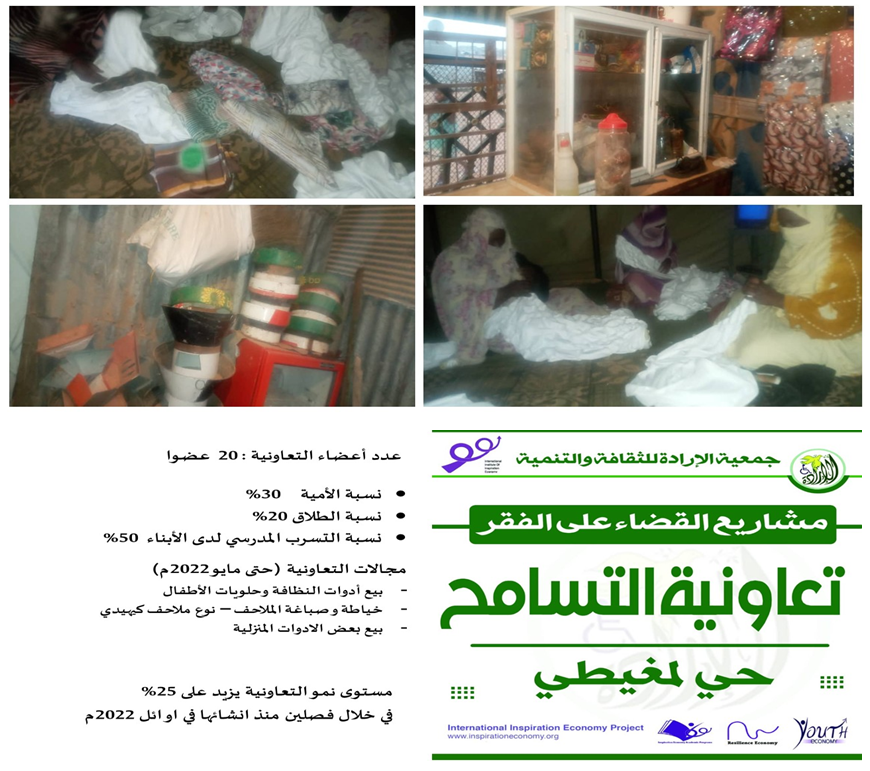 | Figure (5). Photo Reflects the ‘Al-Nasr Cooperative’ Team members at the early start of the initiative |
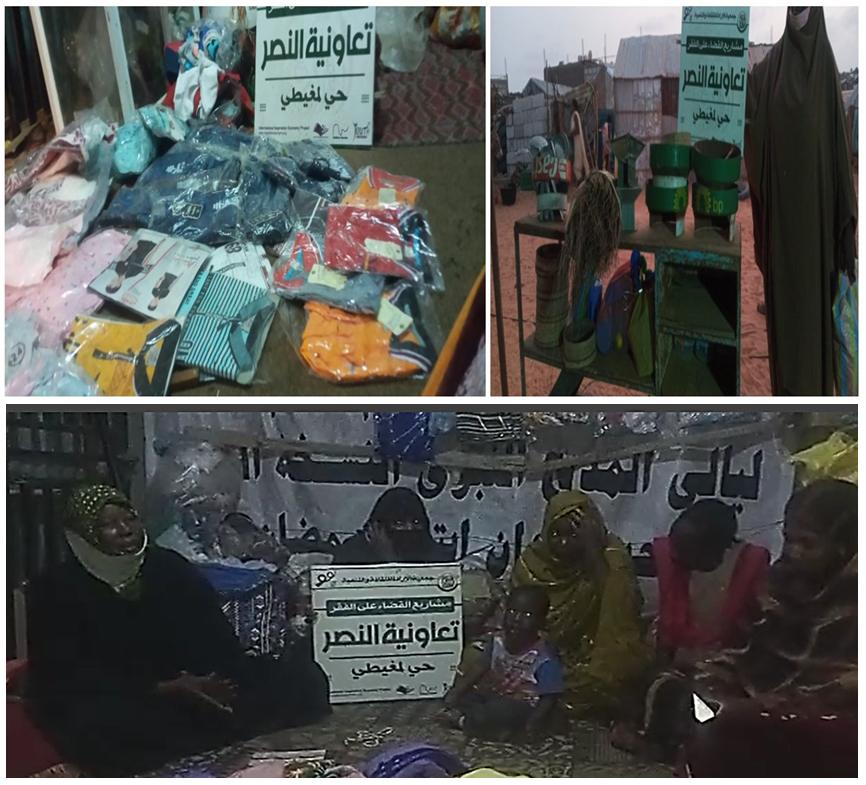 | Figure (6). Photo Illustrates the Development in the Production of ‘Al-Naser Cooperative’ |
4.3.5. Case of Al-Tasamoh Cooperative – ‘A Tale of Flexibility’
- The Al-Tasamoh Cooperative, launched on the same day as Mat Moulana, was unique in its structure. Divided into two independent groups of 10 women each, the cooperative focused on selling cleaning supplies, children’s sweets, household items, and sewing and dyeing milhafas. With an initial capital of $460, the cooperative quickly grew, reaching a value of $610 within the first month. Its growth rate exceeded 25%, a remarkable achievement for a newly established venture.
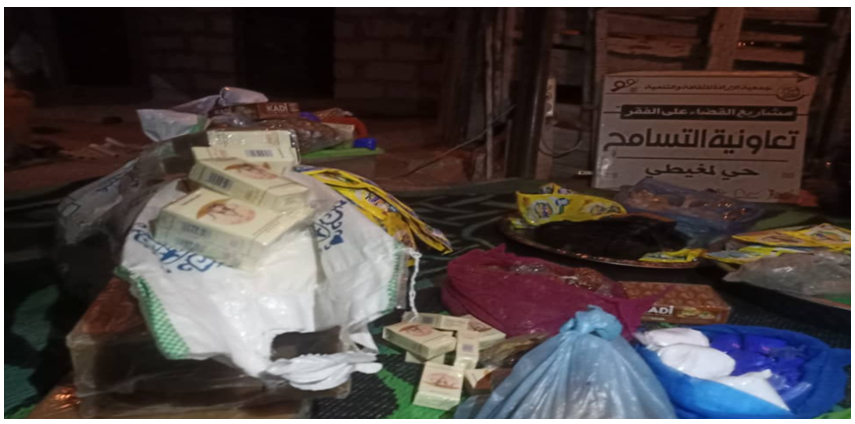 | Figure (7). Photo Reflects the ‘Al-Tasamoh Cooperative’ Team members at the early start of the initiative |
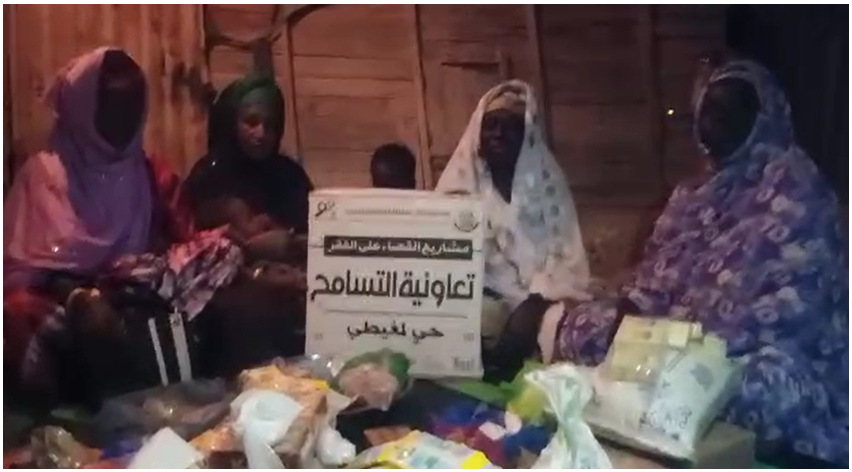 | Figure (8). Photo Illustrates the Development in the Production of ‘Al-Tasamoh Cooperative’ |
4.4. A Community Transformed
- As the months passed, the Lemghity Neighbourhood Cooperatives began to bear fruit. The women, once confined by poverty and limited opportunities, now stood as pillars of their community. They not only earned income but also gained confidence, skills, and a sense of purpose. The youth, too, found new avenues for growth, participating in leadership roles and skill-building activities while seeing a future for their life and their families. The initiatives’ holistic approach—combining economic empowerment with social and educational support—created a ripple effect, improving the quality of life for entire families.The journey was not without its challenges. Marketing remained a hurdle, and the need for continuous training and support was evident. Yet, the association’s commitment to monitoring and adaptation ensured that the cooperatives stayed on track. Monthly and quarterly reports documented progress, while regular discussions with members helped identify and address obstacles.
4.5. Looking Ahead
- The Lemghity Neighbourhood Cooperatives are more than just poverty elimination or poverty eradication projects; they are a testament to the power of community, collaboration, and resilience. Over the next two years, the association plans to expand its efforts, launching more cooperatives and refining its approach based on lessons learned. The ultimate goal is not just economic stability but a transformed way of thinking—a shift from dependency to self-reliance, from despair to hope.The ultimate success of these cooperatives is measured not just by financial metrics but by the tangible improvements in the lives of the beneficiaries. The story of Lemghity is still being written, but its chapters are filled with inspiration, determination, and the promise of a brighter future.
6. Conclusions and Recommendations
- The story of the Lemghity neighbourhood is one of resilience, determination, and collective action. Through the Inspiration Cooperatives initiative, women and youth have not only improved their economic conditions but also redefined their roles in the community. As the initiative continues to grow, it holds the promise of a brighter future for the people of Lemghity and beyond—a future where poverty is no longer a barrier to opportunity, and where communities thrive in the face of adversity.
6.1. Challenges and Lessons Learned
- While the anti-fragile approach holds promise for poverty elimination, it is not without challenges. For example, weak infrastructure, which limited access to markets, transportation, and communication networks, hindered the growth and sustainability of anti-fragile initiatives (Wanyama et al., 2009). The cultural barriers, the deep-rooted social norms and gender inequalities can limit the participation of certain groups, particularly women, in anti-fragile programs (Mazzarol et al., 2014). The amount of resource constraints, especially the financial one, made the anti-fragile interventions a priority in such a situation (Develtere et al., 2008). Despite these challenges, the lessons learned from the Inspiration Cooperatives initiative in Mauritania offer valuable insights for building anti-fragility in other contexts. Key takeaways include the importance of participatory approaches, continuous learning, and adaptive management in ensuring the success of anti-fragile programs.
6.2. Reflections on Applying Anti-fragility Theory on Poverty Elimination Projects
- Anti-fragility is not just about surviving uncertainty—it’s about thriving in it. By embracing volatility, building optionality, and learning from small failures, communities can reduce their vulnerability and become stronger, more adaptable, and more capable of navigating an unpredictable world. Below is a proposed conclusion for the paper on the Inspiration Cooperatives initiative in the Lemghity neighbourhood of Nouakchott, Mauritania. This conclusion summarizes the key findings, highlights the significance of the initiative, and offers recommendations for future action.The Inspiration Cooperatives initiative in the Lemghity neighbourhood of Nouakchott, Mauritania, represents a transformative approach to poverty alleviation and community development. By establishing cooperatives in diverse income-generating activities such as sewing, dyeing, poultry farming, and event management, the initiative has empowered women and youth, fostered resilience, and created sustainable economic opportunities. Grounded in the principles of anti-fragility, the initiative has demonstrated how communities can not only withstand shocks but also thrive and grow stronger in the face of adversity.
6.3. Examples of Effective and Yet Simple Anti-Fragility Approaches that enhance the Capacity for Poverty Elimination with a Neighbourhood
- 6.3.1. Selective Economic Empowerment: The selection of the coops leaders and the consistent mentorship to them, provide the whole coop members with reliable source of confidence that enable them to improve their living standards and invest in their families’ education and well-being. For example, the Mat Moulana Coop achieved a 30% growth rate within the first month, while the Al-Tasamoh Cooperative grew less than 20% due to the type of leadership.6.3.2. Social Cohesion: By fostering a spirit of cooperation and mutual support, the initiative has strengthened social ties within the community. Members have reported increased confidence, a sense of purpose, and improved relationships with their families and neighbours.6.3.3. Selective Skill Development: The selective training crash courses in literacy, basic math, entrepreneurship, and technical skills have equipped members with the knowledge and tools needed to succeed in their ventures. This has enhanced their ability to adapt to changing circumstances and seize new opportunities.6.3.4. Resilience Building: The initiative’s focus on diversification, redundancy, and decentralized decision-making has reduced the community’s vulnerability to economic and environmental shocks. For instance, the introduction of short-term loans from cooperative profits has provided them with their own ‘safety net’ during emergencies.
6.4. Limitations of This Study
- The study has several limitations that need to be taken into consideration for further studies in the same line. For example, the sample size of only taking three coops limits the generalizability of the findings. The study covers a relatively short period (two years), which may not capture long-term impacts. Due to cultural sensitivity, the researcher respected local customs and traditions during data collection and engaged with community members in a respectful and inclusive manner.
6.5. Implications of This Study
- This study contributes to the literature on cooperative-based models for poverty alleviation and anti-fragility by providing a detailed case study of the Inspiration Cooperatives initiative in a challenging socio-economic context.A variety of anti-fragility approaches are used here, such as focusing on the role of education, skill development, and social support in building resilience and reducing vulnerability. Therefore, this study offers practical insights for policymakers, practitioners, and researchers interested in replicating similar initiatives in other regions.The broader implications of this study initiative offer valuable insights for policymakers, practitioners, and researchers working on poverty alleviation and community development. Its emphasis on anti-fragility, local ownership, and holistic approaches provides a model for addressing the root causes of poverty and building resilient communities in similar contexts. By selective and minimal approaches neighbourhood can foster its own collaborative projects that would help build anti-fragility in the most challenging circumstances, and prove that transformation away from the vicious cycle of poverty is possible.
ACKNOWLEDGEMENTS
- The author wishes to acknowledge Dr Elhadi Elmoneer, Al-Irada Association Leader, and his team members, as well as the sociology university students in Mauritania. Our acknowledgement is also extended to the three cooperative leaders who trusted the project design, abided by the Inspiration Economy Projects guidelines for all two years, and showed a willingness to overcome challenges.
 Abstract
Abstract Reference
Reference Full-Text PDF
Full-Text PDF Full-text HTML
Full-text HTML